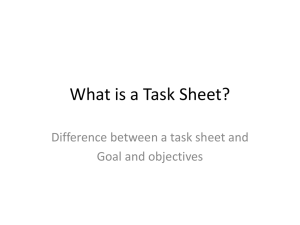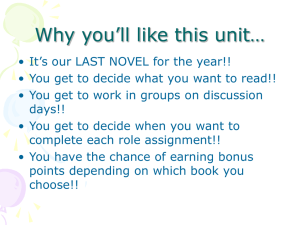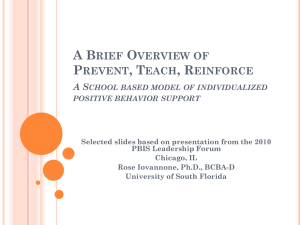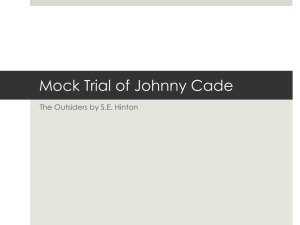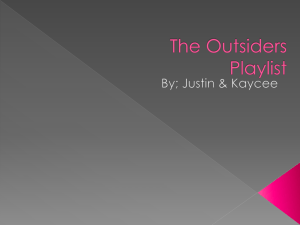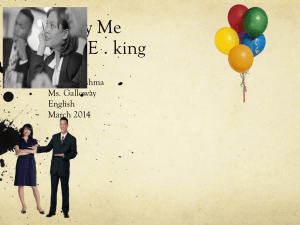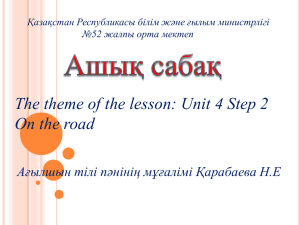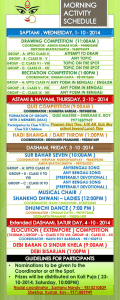JOHNNY CASH Walking a Line in his Shoes
advertisement
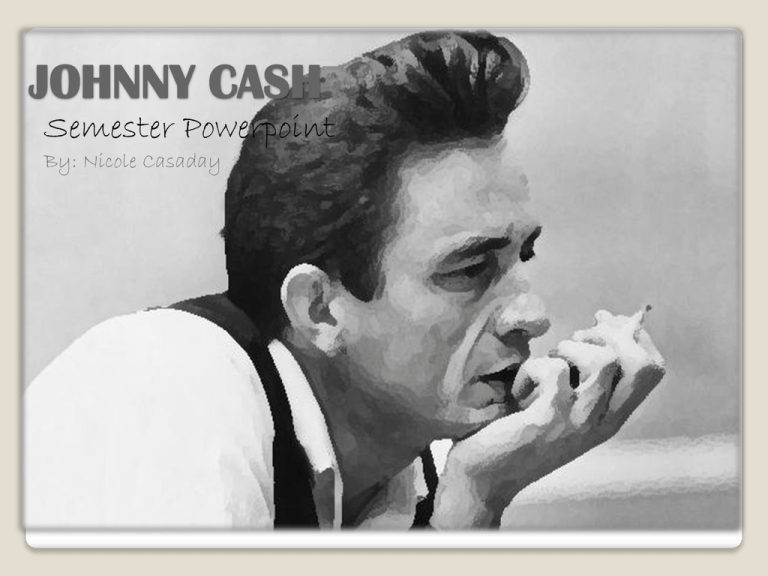
JOHNNY CASH Semester Powerpoint By: Nicole Casaday Biography Walking a Line in His Shoes February 26, 1932 in Kingsland, Arkansas; the one and only Johnny Cash was brought into a loving family of nine created by Ray and Carrie Rivers Cash. Johnny and his family lived In Kingsland until he was at the age of three, where they then moved to Dyess, Arkansas; a Colony in Northeast Arkansas. The Cash family farmed nearly 20 acres filled of cotton, there Ray, Kerry and all seven of their children worked side by side in the crops; including little Johnny. Johnny as a Kid… Cash spent his childhood in Dyess Colony until he graduated high school in 1950, where he then fled off to D e t r o i t in search of work only to find himself in Pontiac, Michigan working in the automotive business. However, Cash soon after enlisted in the U.S. Air Force and was sent off to basic training in Te x a s . While in Texas Cash accidentally stumbled upon love and met his first wife Vivian Liberto, than was almost immediately shipped off to Landsberg, Germany. Guns & Girls Cash started his first band in the military named The Landsberg Barbarians. Cash struggled while desperately trying to break into the music business. When Cash auditioned as solo artist for Sam Phillips’ Sun Records, that following Spring he was in the Sun Studios to record with his new band; The Tennessee Three. Originally consisting of Luther Perkins, Marshall Grant and Red Kernodle. A most popular song of Johnny’s was produced at this time by the name of “Hey Porter,” however, it had a futile running. “Cash’s time in the military may have been a short four years, but those years were crucial in the makings of who Cash became.” Vivian Liberto Becomes… Vivian Cash Vivian Liberto became Vivian Cash in 1954 upon his arrival home. They soon after settled into a little placed they called home in Memphis. Johnny Get’s Hitched… Cash’s next release for Sun Records had a significant increase with “Cry,Cry,Cry”cracking the Billboard’s Top 20 and peaking at No. 14. Than along came what we all know Cash by today; “I walk the Line” topping at the No.1 position for 43 weeks! This album sold of two million copies with other big hits including “So Doggone Lonesome” and my favorite “Folsom Prison Blues.” Johnny’s dream lived on as the fans grew along with his fame and fortune. In 1956 he was invited to perform on the Grand Ole Opry. By 1957 Cash had a handful of remarkable hits and the following years made the decision to switch to Columbia Records in search of more artistic freedom; still longing for gospel records. Mr. Cash Get’s Famous… As his tours grew to an outstanding 300 shows a year his marriage grew cold and divorce seemed inevitable. Cash began relying on narcotics to overlook his problems and to keep up with his hectic pace. By the mid-1960’s Cash had grown uncontrollably addicted and his music career was in serious jeopardy and had begun to fail. “Unfortunately, as his fame and fortune grew, so did his ego and pride. Cash’s life was spinning out of control into a down tunnel and began collapsing before his eyes.” “I want a Love like Johnny & June” During Cash’s crash on life his long time friend and performing partner June Carter stuck by his side and eventually with the help of her family they managed to help him overcome his addiction. Cash desperately fell for June and in 1968 they were married and his career was back on track. He performed numerous live recordings at Folsom Prison and San Quentin and later was awarded with Country Music Association’s Entertainer of the Year and male Vocalist awards in 1969. 1969 continued to become the highlight of Cash’s life as he received a network television spot for “T h e J o h n n y C a s h S h o w ” which aired on ABC. The show featured live guests ranging from Bob Dylan to Louis Armstrong. Cash used the show to break down musical barriers and create genres. He also used the show as a forum to discuss and raise the country’s collective consciousness about social issues of the day. By the age of 48, Johnny Cash became the youngest living inductee into the Country Music Hall of Fame. The Rock and Roll Hall of Fame also bestowed their honor on him in 1995.Cash was became the first ever known to be not only recognized by idolized in both genres of music. Even after all of Cash’s accomplishments he was far from stopping. In 1985, Cash joined with friends Willie Nelson, Waylon Jennings and Kris Kristofferson to form “The Highwaymen.” The ‘super-group’ released three albums between 1985 and 1995 scoring a No. 1 hit with the single “Highwayman” from their first album. In the 1990’s Cash began a struggle with health issues, but entered a professional renaissance after signing with rap producer Rick Rubin’s American record label. In 1994 he won a Grammy for best contemporary folk album and in 1997 for the best country album. In 2001 he once again was awarded another Grammy for best male country vocal performance, followed by three CMA awards in 2003. “By the age of 48, Johnny Cash became the youngest living inductee into the Country Music Hall of Fame.” Cash may be gone, but he continues to live on through his remarkable and irreplaceable music. Unfortunately, some good must always come to an end and Johnny experienced a significant loss when his wife June Carter unexpectedly passed away in May of 2003. Johnny too passed away at the age of 71, on September 12, 2003 at the Baptist hospital in Nashville, Tennessee. Cash lived on as a movie was recreated to reflect on his early romance with Carter, titled Walk the Line and was nominated for Best Picture. Johnny & June had seven children between them; Carlene Carter, Rosanne Cash, Rosey Carter, Kathleen Cash, Cindy Cash, Tara Cash and John Carter Cash. On the morning of January 13, Cash, June Carter Cash, his usual backing band The Tennessee Three; all gathered up and traveled to Folsom. Cash walked up on stage and delivered his iconic, “Hello, I’m Johnny Cash” and the place went wild. Cash later claimed “the Folsom Prison Blues is one of the most recognizable song lyrics in popular music. In 1957 Cash played live for the first time for some inmates at Huntsville State Prison. The event went over so well that Cash continued this practice, playing concerts at prisons around the U.S. inmates at Folsom Prison were the most enthusiastic audience I have ever played to.” The song began scaling both pop and county charts as soon as it hit the radio. At Folsom Prison remains a legendary album, with millions of copies sold and tons of praise heaped upon it. Folsom Prison Blues Song History Reason behind the Rhyme June Carter wrote the song ‘Ring of Fire’ with the help of her friend Merele Kilgore to describe her relationship with Johnny Cash. She felt being around Cash was like being in a “ring of fire.” As previously stated Cash was involved in drugs and had a very volatile lifestyle and June saw him through to the end. June wrote this song before her and Cash were married, and continued her fire like life style with Cash for the next 35 years. Cash’s version became one of his biggest hits, and his marriage to June four years later helped save his life. According to the Rolling Stone magazine’s Top 500 Songs, June Carter wrote this song while worried about Cash’s wildman ways – and aware that she couldn’t resist him. “There is no way to be in that kind driving around aimlessly one night, of hell, no way to extinguish a flame that burns, burns, burns,” she wrote. “The Ring of Fire” stands today as one of Johnny’s most widely known hits with its catchy tune and deep bass. This song like many others of Cash’s resembles a very important part of his life, and it makes it even better that his beloved wife of 35 years wrote for him, about him. Ring of Fire H U R T “Hurt” was first written and recorded in 1994 by the “Nine Inch Nails” Trent Reznor, and in 2002 Cash put his own country twist on it and made the song his own in his album - “American IV: The Man Comes Around.” The accompanying music video, directed by Mark Romanek is nominated for seven MTV Vido Awards and wins for Best Cinematography. Cash claimed, “It is the best anti-drug song I had ever heard.” The song touched Cash as he could relate to each individual word sang. The song talks about hurting yourself, and that each person has the choice to make the pain stop, it’s whether or not you make the right decision. April 2, 1956 Cash recorded his single “I Walk the Line” . May 1, 1956 the song was released by Sun Records and produced by Sam Phillips. “I Walk the Line” got its number one Billboard hit for the group, and remained there for over 43 weeks, and sold over 2 million copies. wrote the song backstage one night in 1956 in Gladewater, Texas. I was newly married at the time, and I suppose I was laying out my pledge of devotion.” I Walk the Line. JOHNNY CASH Listening Guide Ring of Fire - 2:24 0:00 Rest 0:30 Johnny always begins with an introduction and then a slow, steady beat starts. Trumpets blurt out a Spanish tune for three pitches, three consecutive times. Johnny’s deep, rasp voice begins to sing. With the high pitch back up singers in the background. 1:00 Johnny begins singing on tune with slow, dramatic beats that carried over from the beginning segment. The beats are made by a bass guitar using only one pick (string). This beat carries on throughout the entire song. 1:30 Three trumpets chime in again right before and during the chorus. As the guitar in the background keeps a steady quick upbeat tune. 2:00 The trumpets continue ever 10 consecutive seconds with a very loud and sharp pitch. 2:30 Johnny’s words fade, the last trumpet has its play and the beat comes to a complete stop after a quick duple time. Folsom Prison Blues - 2:25 0:00 Rest 0:30 Johnny begins with an introduction and immediately a quick, short guitar strum is played with small pauses between each note. In the live version the crowd goes wild with joy. A steady clap begins from the crowd every 2nd count on the beat of the guitar. 1:00 Johnny begins singing at a steady tune. The peppy and upbeat guitar carries on continuously throughout the song with two counts. 1:30 Right before each chorus the beat speeds to a quick rhythm then carries out with the same rhythm as the beginning. Johnny gives out hoots and hollers out to the crowd. 2:00 The strings repeat the introduction in quick a short notes with the solo guitar. 2:30 The song ends with the quick chorus rhythm in the background as Johnny’s voice fades. The crowd goes wild again as Johnny thanks them for coming out. Walk the Line Hurt 2:43 0:00 Rest 0:30 A bass guitar begins with a steady quick two note strum. Johnny begins with an introduction then a slow beat on the guitar begins with 3-4 chords. It then fades into 2 chords and the singing begins. Along side the guitar is a steady rattle shake creating an irresistible beat. 1:00 This lengthy scale from the string guitar remains as two sets of a duple meter begins. After each verse Johnny’s gives a few second quivering hum, before he begins his next verse. 1:30 The bass guitar joins with the harmony to the once solo guitar and the volume is at is peak and the bass takes over the melody with major percussion becoming louder and more prominent. 2:00 The guitar carries the same background tune throughout the entire song until two beats of light and fast strings correlate in-between. 2:30 Johnny’s voice begins to fade the bass guitar drags on. 4:03 0:00 Rest 0:30 Johnny begins with an introduction then a very slow and calming guitar joins in with 3-5 chords repeating four times until Johnny begins singing at the 15 second interval keeping the same slow pace. His voice older and raspy and slower then most songs. 1:00 The guitar speeds of the beats per section before, after and during each chorus. 1:30 The music becomes loud, aggressive, and fast. Each of the strums making a dramatic impulse on the song for 30 consecutive seconds. Johnny’s voice is serious filled with emotion and energy. 2:00 Two light strings join in and repeat seven times, before returning to the beginning harmony of 3-5 chords repeating four times. 2:30 Quick set of 3 chords from the solo guitar, as the 3rd verse is sung slow and contently, with deep passion in each word describing his pain and agony. 3:00 Chorus speeds up to an aggressive harmony. Johnny’s voice escalates to pitch higher then the instruments in the background. His voice is clear, the words are each pronounced slowly with passion. 3:30 The melody is very repetitive with a two chord string from the guitar. 4:00 Johnny’s voice slows, the instruments stop then Johnny sings his few last words. Works Cited Holly Bones Music. (n.d.). Retrieved September 15, 2011, from http://www.hollybonesmusic.com/johnny-cash-history.html Johnny Cash. (n.d.). Retrieved September 2011, from http://www.johnnycash.com/ Song Pond - Ring of Fire History (n.d.). Retrieved October 2011, from http://www.songpond.com/blog/how-to-play-ring-offire-by-johnny-cash/ The Boot - Folsom Prison Blues (n.d.). Retrieved October 2011, from http://www.theboot.com/2008/12/12/truth-behindjohnny-cashs-folsom-prison-blues-revealed/ The History of Rock. (n.d.). Retrieved September 2011, from http://www.history-of-rock.com/johnny_cash.htm The Johnny Cash Project. (n.d.). Retrieved September 2011, from http://www.thejohnnycashproject.com IMDB - Johnny Cash (n.d.). Retrieved October 2011, from http://www.imdb.com/title/tt0358273/ MTV's Johnny Cash (n.d.). Retrieved October 2011, from http://www.mtv.com/news/articles/1470173/story-behing-johnnycashs-hurts.jhtml Song Facts - I Walk the Line (n.d.). Retrieved October 2011, from http://www.songfacts.com/detail.php?id=5936
